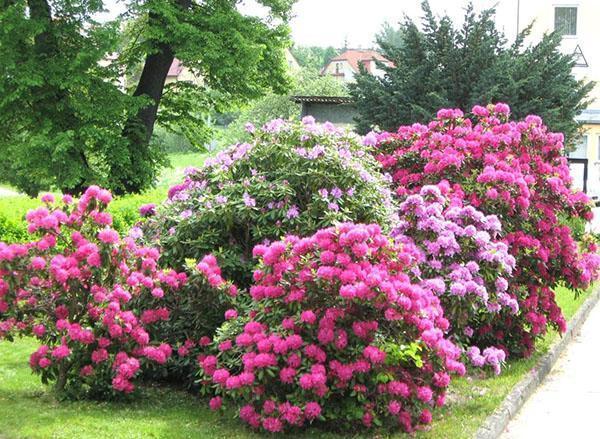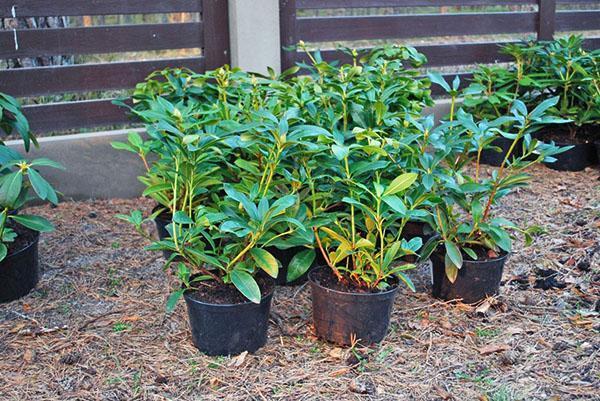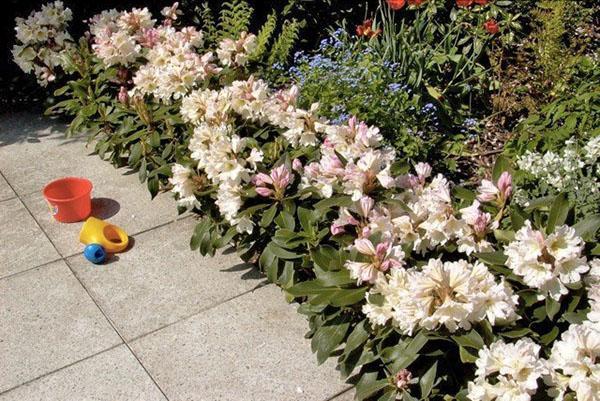We choose a rhododendron for our garden, we plant it and learn how to care for the plant
 Shrubs and trees, which form the numerous genus of rhododendrons, attract gardeners with flowers of different sizes, colors and shapes. But if the summer resident liked the rhododendron, planting and care in the open field will force him to completely surrender to this business. The plant will respond only to competent and attentive care with growth and beautiful flowering.
Shrubs and trees, which form the numerous genus of rhododendrons, attract gardeners with flowers of different sizes, colors and shapes. But if the summer resident liked the rhododendron, planting and care in the open field will force him to completely surrender to this business. The plant will respond only to competent and attentive care with growth and beautiful flowering.
In nature, rhododendrons are found in many parts of the world. Russia is no exception. The Far East, the Caucasus and Siberia are home to several species that are perfectly adapted to local conditions. The most winter-hardy of them are used for growing rhododendron outdoors in the Urals and in other regions with harsh climatic conditions.
Time and place for planting rhododendron in the ground

In order for planting a rhododendron in the middle lane and caring for it in the open field to be successful, you need to choose not only spectacular, but also hardy plants.
There are two favorable periods for planting shrubs in the ground:
- spring, from April to mid-May;
- autumn, from September to October.
The specific period is chosen based on the climatic and weather conditions of the region. The farther south, the earlier the soil warms up after winter, and later winter comes. In the northern regions:
- if you plant a seedling early, it will freeze from frost;
- if you delay in autumn, the plant will not have time to acclimate and will not be able to survive the winter.
In the Urals, in Siberia, in the Northwest, seedlings that have fallen into the garden in spring and received the most attentive care in the summer take root better. In the south, shrubs are planted in summer, but only when there are no flowers on them.
 Plants of this genus have a superficial root system. On the one hand, this helps them gain a foothold on the slopes, but on the other hand, it complicates the care of the rhododendron after planting in the open field and worsens the position of other species growing in the vicinity. To limit the growth of roots, the area allocated for the rhododendron is fenced in by digging in slate, roofing material, a dense material for waterproofing.
Plants of this genus have a superficial root system. On the one hand, this helps them gain a foothold on the slopes, but on the other hand, it complicates the care of the rhododendron after planting in the open field and worsens the position of other species growing in the vicinity. To limit the growth of roots, the area allocated for the rhododendron is fenced in by digging in slate, roofing material, a dense material for waterproofing.
How to plant a rhododendron outdoors
 A hole about 40 cm deep and 60 cm wide is dug under the rhododendron.The bottom, if necessary, is covered with a layer of drainage, and a cone from the mixture is poured over it:
A hole about 40 cm deep and 60 cm wide is dug under the rhododendron.The bottom, if necessary, is covered with a layer of drainage, and a cone from the mixture is poured over it:
- 3 parts sour horse peat;
- 1 part of land from coniferous crops;
- 2 parts of garden soil;
- 1 part washed coarse sand.
Do not forget that in addition to the substrate with high acidity, the plant needs minerals. They are added as a complex fertilizer.
If the rhododendron bush has been without water for a long time before planting in the ground, the root system is immersed in water for several hours. Will cheer up the plant, and it quickly acclimatizes in a new place.
The seedling is placed on top of a man-made mound so that the root collar, when filling, is not lower than the ground level. The roots are gently untangled and spread over damp soil.When the pit is filled up, the soil is compacted and watered again to soak the soil by at least 20 cm.
 After planting, the trunk circle is densely covered mulch based on peat, pine needles, crushed moss, pine bark or oak leaves. In the first year, you do not need to let the shrub bloom. This plant will require a lot of precious forces necessary for rooting. Therefore, all emerging buds are neatly cut off, and caring for a rhododendron in the open field after planting in the spring begins with the installation of a support that will save the still weak crown from wind and other risk factors.
After planting, the trunk circle is densely covered mulch based on peat, pine needles, crushed moss, pine bark or oak leaves. In the first year, you do not need to let the shrub bloom. This plant will require a lot of precious forces necessary for rooting. Therefore, all emerging buds are neatly cut off, and caring for a rhododendron in the open field after planting in the spring begins with the installation of a support that will save the still weak crown from wind and other risk factors.
Outdoor rhododendron care after planting
 Caring for a rhododendron in the garden is not much different from caring for other ornamental shrubs. The plant requires:
Caring for a rhododendron in the garden is not much different from caring for other ornamental shrubs. The plant requires:
- soil moisture:
- regular, but very careful, so as not to damage the root system, removing weeds;
- the same gentle loosening of the trunk circle;
- soil fertilization;
- help with pest attacks.
 During bud formation and flowering, rhododendrons need to get enough moisture on a regular basis. If a plant is in drought conditions, it not only blooms worse this year, but also turns out to be unprepared for the next season. The optimum soil acidity for planting rhododendrons in open ground in the Moscow region or in another region is 4.5–5 units. It is useful to add rotted needles from the forest floor or non-acidified peat to the irrigation water for this ornamental crop.
During bud formation and flowering, rhododendrons need to get enough moisture on a regular basis. If a plant is in drought conditions, it not only blooms worse this year, but also turns out to be unprepared for the next season. The optimum soil acidity for planting rhododendrons in open ground in the Moscow region or in another region is 4.5–5 units. It is useful to add rotted needles from the forest floor or non-acidified peat to the irrigation water for this ornamental crop.
You can determine the moment when the rhododendron needs watering by paying attention to the leaves. If they have lost their tone and gloss, do not hesitate! Abundant watering and irrigation of the crown will return the plant to its former beauty.
Rhododendrons are fertilized from early spring until the end of flowering in the second half of summer. It is also worth feeding the shrubs before flowering, and fertilizers must be applied to the wet soil after watering.
 As top dressing, it is useful to use products with an acid reaction, as well as organics, including:
As top dressing, it is useful to use products with an acid reaction, as well as organics, including:
- manure;
- compost with the addition of rotted forest litter;
- horny bone meal.
Rhododendrons almost do not need formative pruning; sanitary cutting of old, frost-affected or dried shoots is carried out in early spring, before the juices begin to move.
In the summer, when flowering is in progress, it is important to remove wilted inflorescences in order to save the strength of the shrub for laying flower buds next year.
During planting and caring for a rhododendron in the open field, it must be borne in mind that the culture is thermophilic in winter, without shelter it can be seriously affected. Frost protection is prepared in advance. By October in the north and by November in the middle lane, the root zone is sprinkled with peat, and then, before the offensive, the crown is tied and covered with spruce branches and burlap. It will be possible to remove the shelter only in early spring, preferably on a cloudy day, in order to avoid sunburn and cracking of the bark.